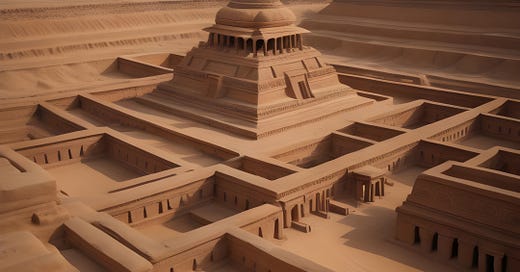The Indus Valley Civilization: An Overview
Unearthing the Mysteries of the Indus Valley Civilization: An In-Depth Exploration of Ancient Wonders and Their Enduring Legacy. #IndusValleyCivilization #AncientWonders #Archaeology
The echoes of ancient history resonate through the sands of time, revealing stories of remarkable civilizations that have shaped our world. Among these, the Indus Valley Civilization stands as a testament to human ingenuity and progress. Its rise and fall have left behind a legacy of mystery and marvels that continue to captivate archaeologists, historians, and enthusiasts alike. In this edition of "Ancient Wonders," we embark on a journey through the enigmatic world of the Indus Valley Civilization.
Introduction
The Indus Valley Civilization, often referred to as the Harappan Civilization, thrived in the vast floodplains of the Indus River and its tributaries, spanning what is today Pakistan and northwest India. Flourishing between approximately 3300 BCE and 1300 BCE, it was one of the world's earliest urban cultures, contemporaneous with the ancient civilizations of Egypt and Mesopotamia. This remarkable civilization left behind a wealth of archaeological evidence, including well-planned cities, intricate artwork, and a script that has yet to be deciphered fully.
Geography and Environment
The geographical setting of the Indus Valley Civilization played a pivotal role in its development. The fertile alluvial plains of the Indus River provided ideal conditions for agriculture, leading to surplus food production. The region's rivers also facilitated trade and transportation, connecting the inhabitants to distant lands.
Urban Planning and Architecture
One of the most striking aspects of the Indus Valley Civilization is its well-planned cities. Harappa and Mohenjo-Daro, the two most prominent urban centers, are excellent examples of sophisticated urban planning. Their streets ran in a grid pattern, and buildings were constructed with standardized bricks, showcasing a high level of civic organization. The presence of public baths and drainage systems reveals a commitment to hygiene and urban sanitation that was ahead of its time.
Economy and Trade
The Indus Valley Civilization engaged in extensive trade networks, extending its influence to regions as distant as Mesopotamia. Archaeological findings suggest the exchange of goods such as textiles, pottery, and metals. The seals discovered at Harappan sites bear inscriptions that offer a glimpse into their economic activities and interactions with other cultures.
Social Structure and Daily Life
While much remains unknown about the social structure of the Indus Valley Civilization, it is believed to have been organized hierarchically, with evidence of a ruling class. The majority of the population likely engaged in agriculture and trade. Intricate pottery, jewelry, and figurines provide insights into their aesthetic sensibilities and daily life.
Religion and Belief Systems
The spiritual beliefs of the Harappan people remain largely enigmatic, primarily due to the absence of written records or temples. However, various figurines and artifacts suggest the presence of deities or religious practices. The famous "Dancing Girl" figurine and the "Pashupati Seal" hint at a complex belief system.
Script and Language
One of the enduring mysteries of the Indus Valley Civilization is its script. Archaeologists have discovered thousands of inscriptions, yet they remain undeciphered. The script is composed of unique symbols, and its meaning continues to elude scholars. Unlocking this ancient code could provide invaluable insights into the culture and language of the Harappan people.
Decline and Legacy
The Indus Valley Civilization eventually declined, with several theories proposed for its downfall. Factors such as ecological changes, natural disasters, or invasions have been suggested, but no single cause has been definitively established. Regardless of its end, the legacy of this civilization lives on in the cultural, technological, and artistic contributions it made to the world.
Conclusion
The Indus Valley Civilization stands as a testament to human achievement in the ancient world. Its advanced urban planning, sophisticated architecture, and enigmatic script continue to captivate scholars and enthusiasts alike. As we delve deeper into the mysteries of this ancient wonder, we gain a greater appreciation for the rich tapestry of human history that has shaped our world.
In future editions of "Ancient Wonders," we will continue to explore the fascinating aspects of this remarkable civilization, from its art and culture to its connections with other ancient societies. Stay tuned for more discoveries from the depths of history.
Thank you for joining us on this journey through the Indus Valley Civilization. Until next time, keep exploring the wonders of the past!




